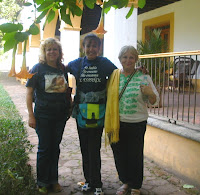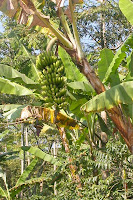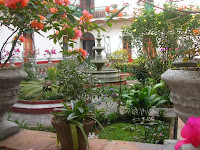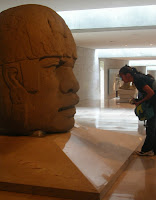
Imagine! When this tree was a seedling, Cortez had not yet arrived in México to begin his conquest of the Aztec empire. Moctezuma, Aztec ruler was in power or soon to be.


Cece arrived for a visit by bus on Friday, Jan. 11, and left in the afternoon on Sunday. During the time she was here, we covered a lot of territory in Xalapa and nearby. On Saturday, we took a bus to Xico and from there walked a couple of kilometers to the Texolo waterfall. The cobbled road was lined on both sides with banana and coffee trees.
On Saturday, we took a bus to Xico and from there walked a couple of kilometers to the Texolo waterfall. The cobbled road was lined on both sides with banana and coffee trees.
As we walked along the path toward the falls, I was amazed to hear someone holler my name several times, and then I saw Elsa Malpica, another English teacher at the Centro de Idiomas, waving at me from a faraway observation deck. We soon met up with her and her two handsome sons and took a few photos of the river before Cece and I decided to head back, thinking that if we hurried we'd have time to get to El Lencero before it closed.
But on more careful thought, we realized that we wouldn’t have time to take a bus back to Xalapa and from then on to El Lencero in the opposite direction, so we changed our plans and took a bus to nearby Coátepec for a leisurely late lunch and a look around before going back to Xalapa.
 Cece explained to me that, in Mexico City, chelada contains picante sauce whereas michelada doesn’t—but just the opposite was true at the Coffino, where the michelada had the hot sauce. Cece advises asking before ordering: Which contains the hot sauce here--the chelada or the michelada?
Cece explained to me that, in Mexico City, chelada contains picante sauce whereas michelada doesn’t—but just the opposite was true at the Coffino, where the michelada had the hot sauce. Cece advises asking before ordering: Which contains the hot sauce here--the chelada or the michelada? After lunch and a look around Coatepec's center, we took the bus back to Xalapa, cleaned up, and went to La Casona del Beaterio, a restaurant where we ate with Margarita, her friend Sylvia, and Miriam and then listened to a musical group play traditional Mexican music. I liked the lead singer’s voice so much, I bought his CD: “Elfego Villegas.”
After lunch and a look around Coatepec's center, we took the bus back to Xalapa, cleaned up, and went to La Casona del Beaterio, a restaurant where we ate with Margarita, her friend Sylvia, and Miriam and then listened to a musical group play traditional Mexican music. I liked the lead singer’s voice so much, I bought his CD: “Elfego Villegas.” On Sunday after visiting El Lencero hacienda, we took the bus to Xalapa’s Museo de Antropología, which is known especially for its fine collection of Olmec heads. (View this website to learn just how advanced the Olmecs were.)
On Sunday after visiting El Lencero hacienda, we took the bus to Xalapa’s Museo de Antropología, which is known especially for its fine collection of Olmec heads. (View this website to learn just how advanced the Olmecs were.)  the silent voice of Mexico’s oldest culture, perhaps that of the mother civilization of our continent. The Olmecs changed rain into harvests, sun into a calendar, rock into sculpture, cotton into cloth, wanderings into commerce, hills into thrones, jaguars into religion and men into gods.”
the silent voice of Mexico’s oldest culture, perhaps that of the mother civilization of our continent. The Olmecs changed rain into harvests, sun into a calendar, rock into sculpture, cotton into cloth, wanderings into commerce, hills into thrones, jaguars into religion and men into gods.” Before Cece took the bus back to Mexico City, we ate lunch with Margarita and Miriam at the Mesón de Alférez. Then Cece took a taxi to CAXA, the bus station in Xalapa, to catch the bus back to Mexico City.
Cece, I hope you come back! I enjoyed your visit and the time we spent touring around.



No comments:
Post a Comment